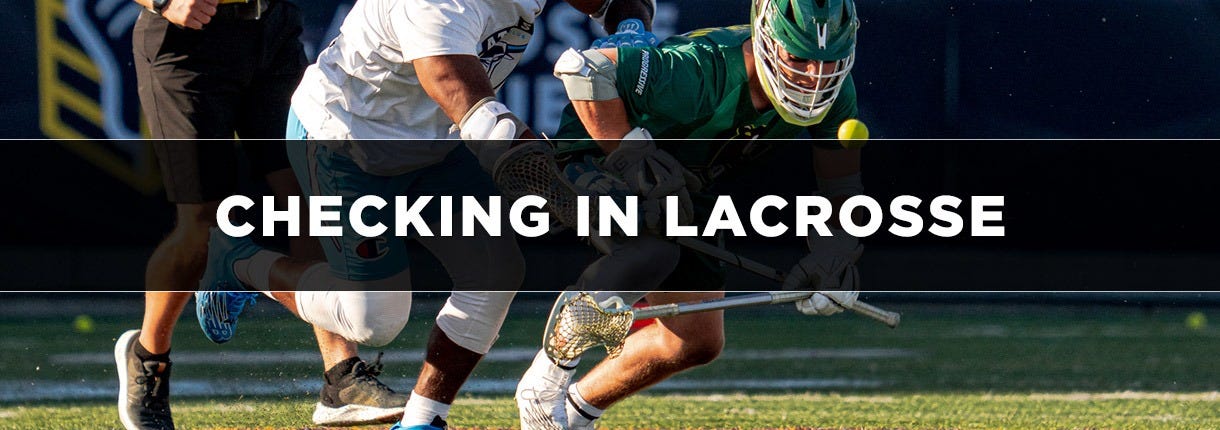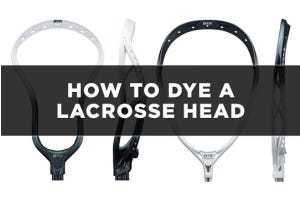A Guide to Checking in Lacrosse

Lacrosse checking is an essential skill for any lacrosse player, in any position, to understand and master. Knowing the rules, types of checks, and when checking is allowed can be daunting even for some advanced players. We’re here to help you out – in this guide, we’re covering everything from passing and throwing a ball to official rules on what types of lacrosse body checks are allowed. We’ll also look at what constitutes illegal play so you can be confident the next time you body or stick check on the field.
Looking for the best lacrosse gear? Lacrosse Monkey has you covered with everything you need, from lacrosse shoulder pads to lacrosse elbow and arm pads to lacrosse rib and kidney pads. We’ve got all the top-of-the-line latest lacrosse helmets and lacrosse gloves.
In this article, we’ll cover:
Body checking in lacrosse is allowed under certain circumstances. In youth and women’s lacrosse, checking is not permitted. At higher levels of play though – like NCAA Men’s Lacrosse – some checking is permitted but there are additional rules you need to know.
Understanding the official rules for lacrosse checking is important, as they are essential for ensuring safety and fairness on the field.
- In youth play, body checking is not allowed; however, lacrosse stick checks are allowed.
- Stick checks are when players legally knock or dislodge the ball from an opponent while it’s in their possession. This must be done without making contact with any other part of the opposing player’s body or uniform.
- Players can make take-out checks on opponents who do not possess the ball if they attempt to gain control of a loose ball in an area known as “the goal area” (defined as between two creases).
- Take-out checks can only be delivered using your long crosse. They must avoid contact with other parts of the opponent’s body or uniform shorts and shoulder pads.
- If any check leads to an illegal hit on another player, a technical foul will be called and the ball will be given to the opposing side.
- Blindside hits and cross-checking involving contact with more than one part (e.g., arms/hands) are considered unsportsmanlike conduct and may result in penalties for either team depending on the severity determined by game officials.
- No offensive player can enter either defensive half while carrying their crosse unless a referee has awarded possession after gaining control over a loose ball outside this area – even taking out goalie sticks is prohibited.
Lacrosse checking is a key element of the sport, and when done correctly, it can be highly effective. Understanding the different types of lacrosse defensive checks is crucial to playing your best game.
Body Checking
Lacrosse body checking is a type of lacrosse check that involves physical contact between two players. It’s typically used to gain possession of the ball and can be done with either the stick or the body. When using your body, checks must be in a controlled manner – too much force could result in an illegal body-check penalty.
Poke Checking
Poke checking involves using your stick to reach out and poke at the opponent’s stick while holding onto it, trying to knock loose their grip on the ball. This technique requires good hand-eye coordination but can be effective if executed properly. Use care to make excessive contact with the opposing player’s stick, and don’t use excessive force – both these actions could result in an illegal check penalty against you.
Lift Checking
Lift checking occurs when one player uses their stick to lift another player’s on the opposing team. It can also involve lifting on an opponent’s arm pads or uniform shorts if they have them tucked into their belt loops during play – this is known as ‘tuck checking.’ Lift checks require precise timing and accuracy. Any missed attempt may lead to an illegal check penalty being called against you by game officials due to the potential of causing injury.
Trail Checking
Trail checking requires sharp and savvy anticipation of sudden changes mid-play without getting caught off guard. Provided no excessive force is applied, this technique is allowed; however, if judged too severe by game officials, an illegal check penalty may be imposed.
Wrap Checking
Wrap checking involves wrapping both arms around a defender’s waist while simultaneously reaching down with your stick towards their hands, holding onto the lacrosse ball. This move requires tremendous strength and agility as defenders often anticipate wrap attempts coming and will counter accordingly.
Illegal lacrosse checks are a serious issue and can result in penalties for the offending player, regardless of whether they’re intentional or not. Knowing which checks are illegal is essential so you aren’t penalized.
Cross-checking
Cross-checking is an illegal lacrosse check where you use the stick’s shaft to hit another player. This checking style usually occurs when a defender attempts to slow down or stop an offensive player by pushing them with their stick. Cross-checking can be dangerous and should not be used in any situation.
Slashing
Slashing is another form of illegal lacrosse check which involves swinging at an opponent’s body, arms, legs, or head with a stick. Slashing can occur in a struggle for the ball or in retaliation in a heated match.
High Sticking
High sticking increases the risk of accidental contact between sticks and heads, resulting in lacerations and concussions. Avoid high sticking at all costs, as any high stick call will result in a penalty being called. Defensive players must keep their stick below shoulder-level when trying to contact an offensive player’s body, arms, legs, or head to secure the ball.
Free Hand Check
Players should always avoid free-hand checking unless instructed otherwise by coaches who can teach proper techniques to use hands defensively without going overboard. Aggressive tugging and pulling on an opponent’s jersey may appear harmless, but can quickly become intense and cause harm.
Illegal Body Check
Not all lacrosse body checks are allowed. Checking an opponent from behind or below the waist is illegal. You can’t check the head or legs, and legal checking is only allowed when the opponent has the ball or is within 3 yards of the ball.
Is checking allowed in lacrosse?
Yes, checking is allowed in lacrosse to enable players to gain control, but it must be done within the rules, or a penalty can be called. Note the youth and women’s lacrosse does not allow checking.
What kind of checking is allowed in lacrosse?
Lacrosse body checks are allowed in men’s lacrosse as long as they’re below shoulder-level and not directed at any player’s head or neck area. Body checking is not allowed in women’s lacrosse.
Is checking allowed in women’s lacrosse?
In women’s lacrosse, body checks are not allowed; however, stick checks that follow the proper technique can still disrupt passing lanes and cause turnovers without causing injury to another player.








